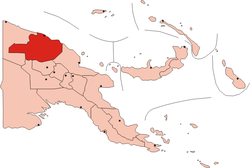Arapesh
The Arapesh are a population of around 5,000 in Papua New Guinea . Their settlement area lies with seven large villages in the hinterland of the north coast, in the East Sepik Province . The region is considered one of the most densely populated New Guinea . The settlement of Ilahita alone has 1500 inhabitants and is therefore almost incomparably large for an autochthonous settlement in the South Pacific .
history
From 1885 the Sepik region was part of the colonial administration of German New Guinea, which was being established . Compared to the highland populations, the Arapesh came into contact with European armed forces very early. They were as laborers in the coastal plantations conscripted . The military presence of the German colonial power and a research assignment from the Reich Colonial Office opened the way for the Austrian ethnologist Richard Thurnwald , namesake of the Thurnwald Mountains , to explore the Sepik region as part of the Empress Augusta River Expedition . After the First World War , the Arapesh area became part of the Australian territory of New Guinea , during the Second World War the Japanese occupied their villages before they were again driven out by the Australians after the end of the war. Parallel to the events, the "Evangelical South Sea Mission" was established on Sepik.
Culture
In contrast to the immediately neighboring Abelam , who speak a non- Melanesian language derived from the Sepik languages (sub-form of the Ndu dialect) , the Arapesh communicate in the Combio Arapesh language, which is part of the Torricelli language family , Arapesh . Despite this clear linguistic delimitation, the two ethnic groups can hardly be distinguished culturally, because there are strong influences of the Abelam on the Arapesh culture.
As the ethnologist Margaret Mead in particular attested in the 1930s, these cultural penetrations extend from the social structure, the introduction of the secret alliance- like tambaran cult, through the style and construction technology of the men's house , to the similarity of the cultivation of the land and, particularly noteworthy, the ceremonial yams festival . In her field studies, Mead even asked herself whether the Arapesh were fully acculturated to the Abelam . The high degree of social-psychological assimilation with simultaneous linguistic disparity gives linguists to this day problems with the classification and identification of various New Guinean ethnic groups, because the Arapesh are not an isolated case.
The descendant structures are patrilinear . The husband or his family take up residence after marriage . Most marriages are concluded in the common village, with sister swap marriages and child betrotals being common practice . Elderly not only do not get divorced , but are subject to the rules of increased duty of assistance and support towards younger people, which applies in particular to non-same-sex siblings of the parents for mother brothers towards the subsequent boys. Married women live in their own house with husband and children. The men have separate refuges (yams) outside the house, but in its immediate vicinity. There the ritually significant objects are kept; The wives are forbidden to enter these storage locations. The adolescent offspring reinforce the father's ritual activities in the yam house. Once their own child has left the house, the couple turn to each other more intensively.
The Arapesh are considered in the literature both internally and externally and among the sexes as an unusually peaceful ethnic group. The Tambaran cult, sometimes described as extremely violent, forms an obvious contrast to this. In the 1930s, Margaret Mead published on the theme of the aggression (see the Mead-Freeman controversy and Social Affairs of the Arapesh ) a comparative study , in which the (now increasingly controversial) resulted knowledge of the peacefulness of Arapesh. On the basis of these findings, the social psychologist Erich Fromm assigned them terminologically to the “life-affirming societies”, which are characterized by a pronounced sense of community with great social equality, friendly child-rearing, tolerant sexual morality and a low tendency to aggression.
economy
The Arapesh live in a swampy area with regular flooding between November and April, making malaria the leading cause of death. In the dry seasons, however, water scarcity is sometimes complained.
The cultivation of yams, in addition to taro , sago , bananas, sugar cane as well as papaya , coconut and breadfruit for their own use is an important traditional subsistence strategy for the Arapesh. The sweet potatoes, which are often grown in the highlands, are only grown casually by the Arapesh; the same applies to cassava . Meat consumption can be classified as rare and mainly on ceremonial occasions.
See also
literature
- Susanne Schröter : Witches, warriors, cannibals , fantasy, domination and gender in New Guinea; Muenster; Hamburg: Lit. 1994 (women's cultures - men's cultures; 3.); ISBN 3-8258-2092-0
- Margaret Mead : The marsalai cult among the Arapesh, with Special reference to the rainbow Serpent beliefs of the Australian Aborigines. In: Oceania 4 (1): 37-53 (1933)
Individual evidence
-
↑ a b c d e f
The ethnologist Susanne Schröter, who makes brief explanations of various ethnic groups in the appendix to the book (Arapesh: pp. 273–277), prefers to refer to the basic studies of the primarily scientifically employed researchers; in the case of Arapesh: Mead (1930s) and Tuzin (1970s):
Susanne Schröter : witches, warriors, cannibals, fantasy, rule and gender in New Guinea (women's cultures - men's cultures; 3.) . In: Women's cultures - Men's cultures - Volumes 1-3) . tape 3 , no. 1 . LIT Verlag, Münster, Hamburg, Germany 1994, ISBN 3-8258-2092-0 , p. 372 (German; IT book version (accessed on March 5, 2016)). - ↑ Heinzpeter Znoj: History of social and cultural anthropology. 5th lecture: German ethnology and racial studies during the Nazi regime. (PDF; 226 kB) (No longer available online.) Institute for Social Anthropology, University of Bern, p. 1 , archived from the original on September 23, 2015 ; accessed on March 4, 2016 (4 pages; documents for the lecture, undated). Info: The archive link was inserted automatically and has not yet been checked. Please check the original and archive link according to the instructions and then remove this notice.
-
↑ a b c d
Donald F. Tuzin is considered to be the leading scientist on the ethnology of the Arapesh ethnic group in recent research:
Donald Tuzin: The Ilahita Arapesh: Dimensions of Unity. In: The Ilahita Arapesh: Dimensions of Unity. University of California Press. Ltd., Berkeley and Los Angeles, USA, 1976, accessed March 4, 2016 . - ^ Languages of the East Sepik Province: Maprik district
- ↑ Language subfamily: Arapesh
-
↑ a b
Despite the controversy of parts of her research results (see, for example, the critical approach of her husband, the anthropologist Reo Franklin Fortune) Margaret Mead is still the most important basic researcher among the Arapesh:
Margaret Mead : The Mountain Arapesh (with a new introduction by Paul B. Roscoe). In: The Mountain Arapesh (with a new introduction by Paul B. Roscoe). Anthropological Papers of the American Museum of Natural History, 1938, accessed March 4, 2016 . - ^ A b Library of Congress: Margaret Mead: Human Nature and the Power of Culture; Papua New Guinea: Sex and Temperament
- ↑ Erich Fromm : Anatomy of human destructiveness . From the American by Liselotte et al. Ernst Mickel, 86th - 100th thousand edition, Rowohlt, Reinbek near Hamburg 1977, ISBN 3-499-17052-3 , pp. 191-192.


